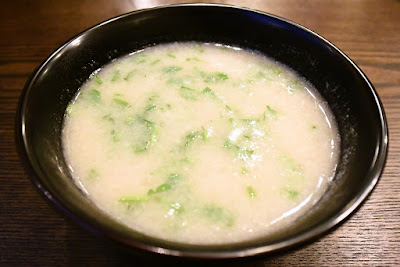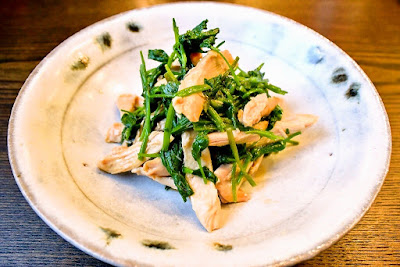All recipes are for 2 servings unless noted. Oil is canola oil and salt is kosher salt.
2016-03-30
2016-03-27
Kumiage-yuba to kani no ankakedon / fresh tofu skin and crab sauce over steamed rice
Heavenly creamy fresh yuba meets sweet Dungeness crab! Mitsuba, with its refreshing bouquet and taste, works as a highlight as the other ingredients blend in harmony. Below, the dish is served with steamed rice cooked with lotus root for a nice crunch and seasonal reminder. Comforting and yummy!
When served with 150 g steamed rice (plus several lotus root slices) and 60% of yuba-an sauce:
350 calories; 13.2 g protein; 4.1 g fat; 59.4 g carbohydrate; 58.4 g net carbs; 380 mg sodium; 12 mg cholesterol; 1.0 g fiber
When served with 110 g steamed rice (plus several lotus root slices) and 40% of yuba-an sauce:
251 calories; 9.1 g protein; 2.8 g fat; 43.4 g carbohydrate; 42.7 g net carbs; 253 mg sodium; 8 mg cholesterol; 0.7 g fiber
When served with 150 g steamed rice (plus several lotus root slices) and 60% of yuba-an sauce:
350 calories; 13.2 g protein; 4.1 g fat; 59.4 g carbohydrate; 58.4 g net carbs; 380 mg sodium; 12 mg cholesterol; 1.0 g fiber
When served with 110 g steamed rice (plus several lotus root slices) and 40% of yuba-an sauce:
251 calories; 9.1 g protein; 2.8 g fat; 43.4 g carbohydrate; 42.7 g net carbs; 253 mg sodium; 8 mg cholesterol; 0.7 g fiber
Labels:
2 easy,
60 min,
crab,
ginger,
mitsuba,
Recipes - Japanese,
reduced sodium,
renkon,
seri,
simmer,
yuba
2016-03-25
Kumiage-yuba / fresh tofu skin
Kumiage-yuba is a type of fresh yuba tofu skin (beancurd sheets). It has a very silky, creamy texture that melts in your mouth. Making it requires only fresh additive-free tonyu soy milk and some water ... and lots of time.
In my case, 500 cc (about a pint) of soy milk yields only sixteen 20 cm/8" round sheets over 2+ hours. Each sheet takes several minutes to
harvest, so think of it this way -- you have lots of time to take care
of simple tasks in the kitchen, or even get some exercise in front of
the stove! You won't regret the time you spend once you discover how
delicate and tasty these simple creations can be.
2016-03-23
Seri to toriniku no karashijoyu-ae / water dropwort and chicken in mustard soy sauce dressing
Seri water dropwort goes really well with chicken. Here is a quick, light side dish using boiled chicken from making chicken stock.
57 calories (1/2 of recipe); 8.2 g protein; 1.3 g fat; 1.3 g carbohydrate; 0.9 g net carbs; 83 mg sodium (with 50% reduced-sodium soy sauce; approximately 180 mg with regular soy sauce); 39 mg cholesterol; 0.4 g fiber
57 calories (1/2 of recipe); 8.2 g protein; 1.3 g fat; 1.3 g carbohydrate; 0.9 g net carbs; 83 mg sodium (with 50% reduced-sodium soy sauce; approximately 180 mg with regular soy sauce); 39 mg cholesterol; 0.4 g fiber
Labels:
1 very easy,
10 min,
bento,
blanch,
chicken,
karashi,
Recipes - Japanese,
reduced sodium,
seri
2016-03-21
Asupara no kani-ankake / asparagus with thickened crab sauce
Another dish that appears at our table when asparagus season rolls around. The sweet note of juicy asparagus is a natural match with Dungeness crab. This quick, easy and delicious Chinese-style ankake (dish with thickened sauce) is a surefire hit.
79 calories (1/2 of recipe); 8.0 g protein; 2.5 g fat; 6.3 g carbohydrate; 4.6 g net carbs; 189 mg sodium; 20 mg cholesterol; 1.7 g fiber
79 calories (1/2 of recipe); 8.0 g protein; 2.5 g fat; 6.3 g carbohydrate; 4.6 g net carbs; 189 mg sodium; 20 mg cholesterol; 1.7 g fiber
Labels:
10 min,
2 easy,
asparagus,
boil,
crab,
Recipes - Chinese,
reduced sodium,
saute,
shiokoji,
stir-fry
2016-03-19
Kabu to usuage no nimono (genen) / Japanese turnip and thin deep-fried tofu in broth (reduced-sodium version)
Among many variations of nibitashi or nimono simmered dishes, this is one of my favorite combinations. While I continue to use usukuchi soy sauce with its pale color and higher sodium content than regular soy sauce, I cut the amount by more than half. Also reduced is the amount of dashi, sake and mirin, and I add a small amount of rice vinegar to the broth. Kabu leaves are removed from the pot after sauteing to keep their green color, but cooking them in broth actually results in a deeper, more satisfying taste (see Notes).
99 calories (1/2 of recipe); 3.5 g protein; 5.5 g fat; 8.2 g carbohydrate; 6.1 g net carbs; 204 mg sodium; 0 mg cholesterol; 2.1 g fiber
99 calories (1/2 of recipe); 3.5 g protein; 5.5 g fat; 8.2 g carbohydrate; 6.1 g net carbs; 204 mg sodium; 0 mg cholesterol; 2.1 g fiber
Labels:
2 easy,
30 min,
braise,
kabu,
Recipes - Japanese,
reduced sodium,
saute,
simmer,
usuage
2016-03-17
Seri water dropwort
芹 (せり)
Oenanthe javanica
2016-03-15
Kinoko-iri sundupu / soondupu jjigae Korean soft tofu stew with mushrooms
A tasty Korean soft tofu stew has made a comeback at our table! My now typical lineup of seasonings to reduce overall sodium -- shoyukoji soy sauce rice malt, shiokoji salted rice malt and (brown) rice vinegar -- works like a charm again here. The strong taste and aroma of dashi stock made of niboshi dried young sardines and konbu kelp is softened to a deeper note by adding the water used to rehydrate dried shiitake, which is one of assorted mushrooms that go into the stew. All in all, this is very satisfying, filling dish.
248 calories (1/2 of recipe); 18.9 g protein; 13.9 g fat; 16.1 g carbohydrate; 10.1 g net carbs; 574 mg sodium; 219 mg cholesterol; 6.0 g fiber
248 calories (1/2 of recipe); 18.9 g protein; 13.9 g fat; 16.1 g carbohydrate; 10.1 g net carbs; 574 mg sodium; 219 mg cholesterol; 6.0 g fiber
Labels:
2 easy,
30 min,
60 min,
dried shiitake,
eggs,
enoki,
eringi,
fresno pepper,
green onions,
hoshi-shiitake,
Recipes - Korean,
reduced sodium,
serrano pepper,
shiokoji,
simmer,
soup,
stew,
tofu
2016-03-14
Sundupu-yo yannyomu / yangnyeom seasoning mix for soondupu jjigae Korean soft tofu stew
This seasoning mix lets you make tasty soondupu jjigae that is low in sodium!
Whole recipe:
295 calories; 5.0 g protein; 19.8 g fat; 19.9 g carbohydrate; 19.2 g net carbs; 464 mg sodium; 0 mg cholesterol; 0.7 g fiber
1 tsp (6 g):
21 calories; 0.4 g protein; 1.4 g fat; 1.4 g carbohydrate; 1.4 g net carbs; 33 mg sodium; 0 mg cholesterol; 0.1 g fiber
Whole recipe:
295 calories; 5.0 g protein; 19.8 g fat; 19.9 g carbohydrate; 19.2 g net carbs; 464 mg sodium; 0 mg cholesterol; 0.7 g fiber
1 tsp (6 g):
21 calories; 0.4 g protein; 1.4 g fat; 1.4 g carbohydrate; 1.4 g net carbs; 33 mg sodium; 0 mg cholesterol; 0.1 g fiber
Labels:
10 min,
2 easy,
garlic,
ginger,
Ingredient preparation,
kurozu,
make ahead,
Recipes - Korean,
reduced sodium,
shiokoji,
shoyukoji
2016-03-11
Nobiru no nuta / wild garlic in sweetened miso vinegar sauce
Also called nuta-ae or sumiso-ae, this is one of the standard ways to enjoy spicy nobiru wild garlic in spring. A small side dish with punchy taste and aroma that goes well with meals and drinks.
1/2 of recipe:
30 calories; 1.3 g protein; 0.3 g fat; 6.4 g carbohydrate; 4.4 g net carbs; 104 mg sodium; 0 mg cholesterol; 2.0 g fiber
1/2 of recipe:
30 calories; 1.3 g protein; 0.3 g fat; 6.4 g carbohydrate; 4.4 g net carbs; 104 mg sodium; 0 mg cholesterol; 2.0 g fiber
Labels:
10 min,
2 easy,
bento,
blanch,
nobiru,
Recipes - Japanese,
reduced sodium
2016-03-02
Uguisumochi / warbler cake with sweet azuki paste
As plum blossom season approaches, this chubby oblong cake coated with green soybean flour starts to appear at sweets shops. The cake form symbolizes the spring songbird, uguisu, or Japanese warbler -- I wouldn't blame you if you don't see the resemblance in appearance, but once you put it in your mouth, the combination of soft outer cake and silky azuki bean paste inside reminds you of the tenderness of spring.
One cake (1/4 of recipe):
110 calories; 2.5 g protein; 0.6 g fat; 24.0 g carbohydrate; 22.4 g net carbs; 0 mg sodium; 0 mg cholesterol; 1.5 g fiber
One cake (1/4 of recipe):
110 calories; 2.5 g protein; 0.6 g fat; 24.0 g carbohydrate; 22.4 g net carbs; 0 mg sodium; 0 mg cholesterol; 1.5 g fiber
Labels:
10 min,
2 easy,
aodaizu kinako,
azuki,
gyuhi,
kinako,
koshian,
make ahead,
Recipes - Japanese,
sweets
Subscribe to:
Posts (Atom)










